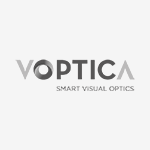Purpose: Different bilateral approaches are currently applied to correct for presbyopia. While they provide reasonable visual acuity over an extended range of object vergences, inter-ocular image quality difference tends to reduce stereo vision. We compared stereo-acuity (SA) with monovision and a small aperture inlay measured by using a binocular adaptive optics instrument.
Methods: For performing the experiment a prototype of a binocular adaptive optics visual analyzer was employed. The experimental system allowed the simultaneous measurement and manipulation of optics in the two eyes of a subject. The apparatus incorporated two programmable modulators using liquid crystal on silicon technology for wavefront shaping and to produce the artificial pupils. The prototype was also equipped with a stimulus generator based on a pair of high luminance micro-displays in order to perform visual testing through the modified optics. Each display was independently projected over its corresponding eye, still simultaneously, creating retinal disparity. For characterizing stereopsis, a three-needle test was programmed. Subjects underwent a forced choice test, discerning if the stimulus, the central wire, was in front or behind the reference two other wires for different disparities. The following cases were tested for the stimulus placed at distance: a) normal (4 mm pupils); b) micro-monovision (-0.75D in one eye); c) monovision (-1.5D in one eye); d) small aperture (1.6 mm pupil in one eye). SA was measured in three subjects with normal stereovision, with paralyzed accommodation. In the experiment 15 runs for each disparity value were completed.
Results: The average results showed a SA around 10 arcsec in the normal case for the tested conditions. The small aperture barely affected stereopsis, with a small average increase to 15 arcsec, although not significantly different than the normal case. Micro-monovision reduced SA by a factor of 4 (to around 45 arcsec). In the 3 subjects tested monovision produced a near random response within our disparity range, revealing a SA larger than 80 arcsec. A simple model based on the measured retinal images for each case tested predicted the SA experimental findings.
Conclusions: A new adaptive optics instrument permits the investigation of the impact of different optical solutions to correct presbyopia, including stereo vision. The small aperture approach does not modify SA due to a moderate retinal disparity. On the contrary, monovision severely degraded stereo vision as a result of largely different image quality in both eyes.
Methods: For performing the experiment a prototype of a binocular adaptive optics visual analyzer was employed. The experimental system allowed the simultaneous measurement and manipulation of optics in the two eyes of a subject. The apparatus incorporated two programmable modulators using liquid crystal on silicon technology for wavefront shaping and to produce the artificial pupils. The prototype was also equipped with a stimulus generator based on a pair of high luminance micro-displays in order to perform visual testing through the modified optics. Each display was independently projected over its corresponding eye, still simultaneously, creating retinal disparity. For characterizing stereopsis, a three-needle test was programmed. Subjects underwent a forced choice test, discerning if the stimulus, the central wire, was in front or behind the reference two other wires for different disparities. The following cases were tested for the stimulus placed at distance: a) normal (4 mm pupils); b) micro-monovision (-0.75D in one eye); c) monovision (-1.5D in one eye); d) small aperture (1.6 mm pupil in one eye). SA was measured in three subjects with normal stereovision, with paralyzed accommodation. In the experiment 15 runs for each disparity value were completed.
Results: The average results showed a SA around 10 arcsec in the normal case for the tested conditions. The small aperture barely affected stereopsis, with a small average increase to 15 arcsec, although not significantly different than the normal case. Micro-monovision reduced SA by a factor of 4 (to around 45 arcsec). In the 3 subjects tested monovision produced a near random response within our disparity range, revealing a SA larger than 80 arcsec. A simple model based on the measured retinal images for each case tested predicted the SA experimental findings.
Conclusions: A new adaptive optics instrument permits the investigation of the impact of different optical solutions to correct presbyopia, including stereo vision. The small aperture approach does not modify SA due to a moderate retinal disparity. On the contrary, monovision severely degraded stereo vision as a result of largely different image quality in both eyes.


